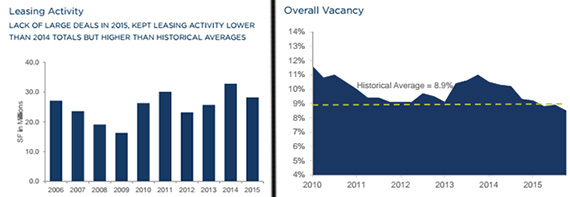Trending
Cushman execs see mixed signals for 2016
Office leasing strong, but Knakal forecasts drop in investment sales

Cushman & Wakefield executives delivered a mixed outlook Tuesday on the city’s commercial real estate market in 2016, as continued macroeconomic strength is expected to drive market fundamentals but major questions persist over the fate of the current cycle.
The commercial brokerage giant noted positive market trends ranging from continued job growth – with 46,000 jobs added in the city in October and November alone, according to principal economist Ken McCarthy – to office asking rents that have hit all-time highs in the Downtown and Midtown South submarkets.
A resurgent financial services sector has helped drive that momentum, with the industry overtaking the TAMI sector to account for 29 percent of all new office leases in 2015, Cushman said.
The year also saw three emerging office markets “substantiated,” according to vice chair Gus Field. Brooklyn, Long Island City and Hudson Yards are becoming increasingly viable options for tenants and landlords alike, he said.
New leasing activity totaled 28.2 million square feet in 2015, representing the third-highest total in the past decade, Cushman data shows. In turn, the overall Manhattan office vacancy rate dropped to 8.5 percent – the lowest it’s been since the end of 2008, when it stood at 8.1 percent.
But those positives were somewhat tempered by indications that 2016 will not be as fruitful as the previous two years, which brought record-breaking transaction and dollar volumes for the city’s investment sales market.
Keeping with previous indications, 2015 saw a record $74.5 billion in sales transactions across the city. Bob Knakal, Cushman’s chair of New York investment sales, cited an “incredible” two-year stretch that also featured a record for buildings sold in 2014.
But Knakal noted “some cracks emerging” after that “unprecedented run of activity” for the city’s commercial real estate market. Cap rates increased for two quarters in a row and there have been bearish indicators for land pricing over the past several months.
He described how “sites that we expected to sell for $750 to $800 a [square] foot” have recently struggled to command more than $600 per square foot, and cited a “significant diminution” in land prices compared to what properties have commanded over the past two years.
“This has been the most difficult year we’ve had making these projections [for 2016] for the first time in a while,” Knakal said. “I’m more stumped this year than I’ve been since 1998.”
He said he expects “significantly lower” dollar volume in the city’s investment sales volume this year, as well as an even greater drop in the number of properties sold.
On the financing side, Steve Kohn, Cushman president of equity, debt & structured finance, described a “very strong year” for the city’s CMBS market, despite total issuances of $100 billion falling somewhat sort of initial projections.
Kohn did note that it’s become “tougher to finance” certain projects as far as capital markets are concerned, with high-end condos being one property type that lenders are increasingly skeptical about – forcing developers to look to debt funds, mortgage REITs and higher-yield markets to finance such projects.




